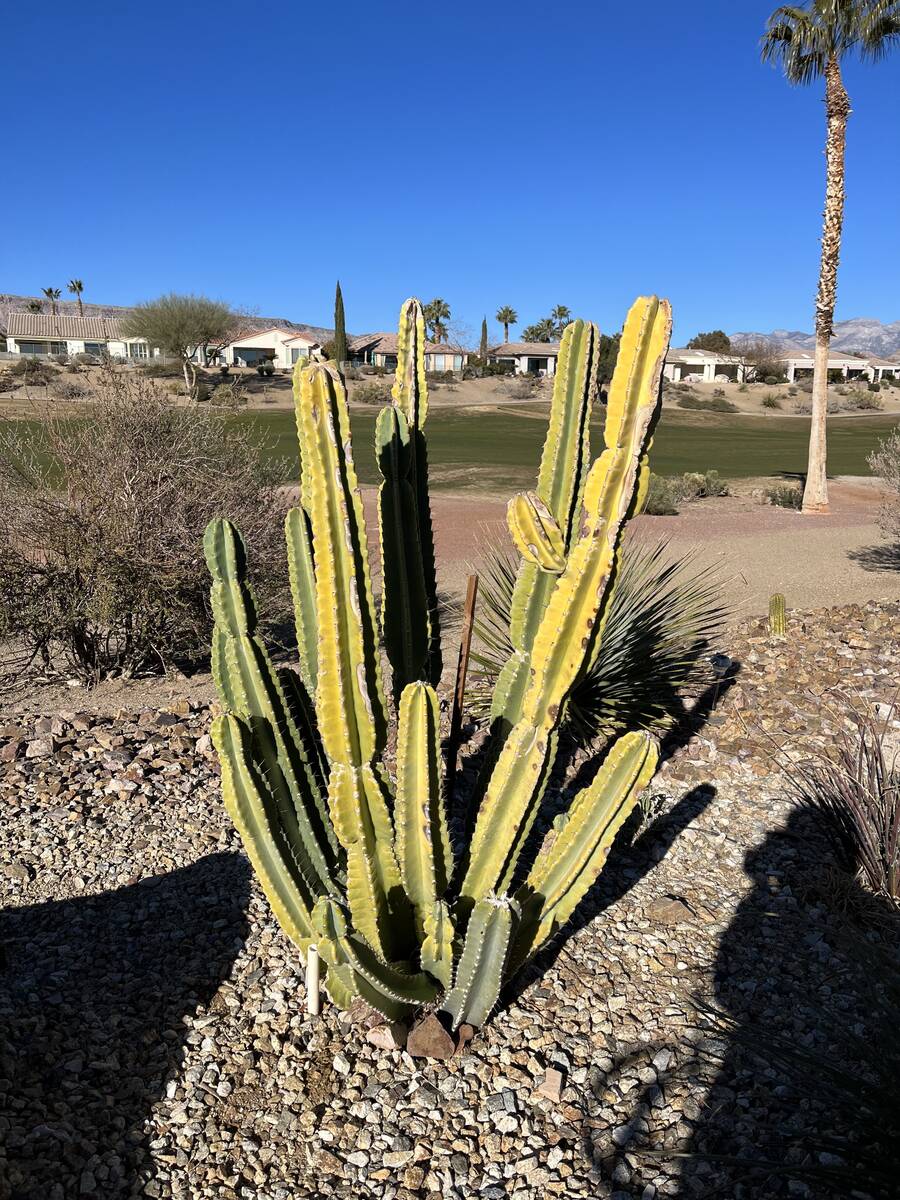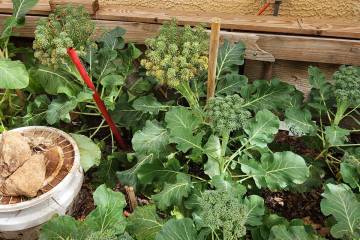Volunteer planting scheduled at Nevada Garden Clubs Center
Mark your calendars for March 4. I am inviting you to an early volunteer opportunity to plant shrubs and flowers around the Nevada Garden Clubs Center on March 4 starting at 7 a.m.
This is your chance to rub shoulders with gardeners experienced with desert gardening and shop with local plant-minded vendors. This opportunity is located at 800 Twin Lakes Drive near Lorenzi Park, close to the Rancho Drive and Washington Avenue intersection. There will be a “plant and seed exchange” starting at 10 a.m. at the same location.
Q: I was so happy to see a column you recently wrote in the RJ concerning bitter orange trees. I have one that was here when I bought my house 16 years ago. It was in a patio pot at that time and I had it replanted, along with a Meyer lemon, in the alley between my house and my neighbor.
My lemon has been giving me fruit for the past approximately eight years and about 30 to 35 lemons. My orange tree has always produced flowers, but no fruit up until two years ago. I got about 25 nice-sized oranges. Last year I got flowers but not a single fruit. Is this a tree that may skip a year in fruit production? I have done nothing to these trees except fertilize with Arizona’s Best Citrus fertilizer on Valentine’s Day, Memorial Day and Labor Day.
A: Skipping a year is called “alternate bearing” and occurs, usually, with older varieties of fruit trees like some almonds and apricots. Bitter orange, like most oranges, produces the majority of its flowers in the early spring. This is the same time we experience freezing weather. Your fruit loss could be because of freezes.
It is important to ask if you saw flowers in the spring and no fruit. That’s an important consideration. If you did, then it was a failure to set fruit. That is either because no pollinators were present (bees and other pollinators like flies and moths) or it froze several times in a row in the early spring.
If you did not see flowers in the spring, then it was because it never flowered. That could be because of some hard pruning that was done, and the tree is recovering, or too much fertilizer was applied too often. This is true particularly of high doses of nitrogen fertilizer such as ammonium sulfate (21-0-0). In either case, the tree grew so vigorously that it never flowered.
Normally one fertilizer application is all that is necessary or two at the most. If two are applied, then apply half of your normal fertilizer application in the early spring and half right after harvest. If harvest is close to your early spring application time then apply fertilizer to citrus just before it gets hot in the early summer.
Avoid making fertilizer applications when it is hot. In the case of citrus that might freeze, avoid fertilizer applications after July.
I noticed that the tree is surrounded by rock mulch. Yet it has good color. Citrus of all types doesn’t usually like rock mulch all that much. The first thing to see is a dark to medium green color in the leaves when it gets unhealthy. That’s why I was surprised with your tree. Maybe your choice of fertilizer helps.
Citrus are from southeast Asia and China. They prefer to grow in soils with a higher organic content than most soils covered in rock.
Along with your fertilizer application try raking back the rock at least 3 feet all around the tree and applying compost or wood chips to the top of the soil. Water it in and rake the rock back on top of it after it is watered.
Do this about every year or every other year at the least. I think your bitter orange will like this type of soil better than soil covered in rock.
Q: I have a Peruvian apple cactus that has been in place about six years and tripled in size since planting. It blooms profusely in the spring and summer. Two branches are now very yellow. I’m not sure why. It was loosely wrapped with burlap in January but was yellow before that. Do you have any suggestions to return it to a healthy color? Should I cut those branches off?
A: Let’s see if we can get the color back in those limbs before pruning it. Not all cacti are for the hot dry Mojave Desert. If the yellowing is due to cold weather or intense sunlight and reflected heat, then moving it to a different spot where it gets afternoon shade might be called for.
I hope you’re not watering it too often. Watering too often can also cause it to yellow. Even though it’s xeric, I wouldn’t water it more than once a month during the heat of the summer. That’s four or five times a year.
When you do water, apply the water so it penetrates the soil 18 to 24 inches deep. Do this to an area that is about 6 feet in diameter.
Use a sprinkler rather than just a hose. The sprinkler will apply the water to that area much slower and so the water will wet the soil slowly, more deeply. My understanding is that these plants come from a higher elevation and get occasional rainfall.
The San Pedro and Peruvian apple cactuses are sometimes confused because they look similar. The spines of a Peruvian apple cactus are considerably longer than those of a San Pedro cactus. Otherwise, they can look similar even though they are in a different genus.
Q: How do I save water in my landscape? I thought I was doing OK until recently the water department told me my landscape watering was out of control.
A: About 70 percent of the water on your water bill is used to pay for water applied to the landscape.
The least expensive way to conserve water is by eliminating plants. Plants use water.
Concentrate on replacing plants with voids that don’t use any water or landscape features that don’t. I call these voids, negative spaces. These negative spaces accentuate the plants that remain.
Select plants to remove that don’t look as good as the others. Remove plants that are closer than 3 feet from the foundation of your home. Keep this area dry.
When finished, about half the area of your landscape should be empty or have voids in it. If half the area of your landscape is not watered and you are careful about watering the rest, that saves at least 40 percent of your water bill.
Leave plants to shade the west- and south-facing walls and windows of a home. These should be planted no closer than 3 feet for small plants (5 feet for taller plants is better) from the foundation of the home. Shading the south- and west-facing exposures of a home helps to lower electricity costs in the summer.
If these plants drop their leaves when it gets cold (deciduous), these plants allow the sunlight to warm the house when it gets cold. Warming the house when it is cold outside helps to lower winter heating costs.
Substitute plants that you remove with different-sized rocks, boulders, slabs, changes in elevation, artwork, painted walls, gazebos and patios. All of these things don’t use any water. Every time you have plants, make an area equal to that area without plants. That simple
Q: We planted a small Meyer lemon tree last spring in the ground. It is living and I have been reading about fertilizing it. We bought some fertilizer from a local nursery but I was wondering if there was a fertilizer that you specifically thought was good and, also, a fertilizing schedule for a small tree. It is only about 3 feet tall.
A: You are trying to “guesstimate” what a soil test from a reputable lab would tell you. A soil test would tell you what nutrients are missing from your soil (from that you can figure out which fertilizer to use).
Soil tests are expensive. A good one costs about $75 from a commercial soil testing lab.
Some states provide a soil test free of charge or low-priced from a state-supported agricultural university. Using a soil test as the basis for selecting a fertilizer is always the preferred way when it is available.
Citrus fertilizers will have other ingredients important to citrus in the bag or they may not. Does it help? Only if it is missing. Look up or google Liebig’s Law of the Minimum. Basically, small citrus trees need a high amount of nitrogen fertilizer and lower amounts of phosphorus and a high or medium amount of potassium.
Older, productive trees should have higher amounts of phosphorus, the middle number, compared to nitrogen and potassium. You can find a similar fertilizer in rose plant fertilizers as well.
Generally speaking, fertilizers that are best for flowering plants are all pretty much the same. Fertilizers best for leafy plants (very low in phosphorus) without flowers are pretty much the same.
But potassium, the last number, is important as well and should be present on the bag in an amount similar to the nitrogen content, the first number. But for backyard gardeners, citrus fertilizers are a safe bet for citrus.
Usually, one application in the early spring is best for most fruit trees. It is important to provide all the nutrients in one or two applications. Just divide the application in half for two applications.
Bob Morris is a horticulture expert and professor emeritus of the University of Nevada, Las Vegas. Visit his blog at xtremehorticulture.blogspot.com. Send questions to Extremehort@aol.com.























